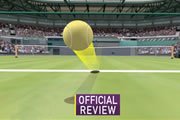A magazine where the digital world meets the real world.
On the web
- Home
- Browse by date
- Browse by topic
- Enter the maze
- Follow our blog
- Follow us on Twitter
- Resources for teachers
- Subscribe
In print
What is cs4fn?
- About us
- Contact us
- Partners
- Privacy and cookies
- Copyright and contributions
- Links to other fun sites
- Complete our questionnaire, give us feedback
Search:
Challenging the Line Judge
You are 14. You have made it to the Wimbledon Junior Final and have the prospect of being the first Brit for over 20 years to win a Wimbledon Trophy. You are going to play on Centre Court with a capacity, partisan crowd to cheer you on. Win or lose you are now a celebrity. What are you looking forward to most?
For Laura Robson the answer was the chance to use a computer program - in fact a piece of serious computer science that has revolutionised the way decisions are made at Wimbledon. The program is Hawk-Eye. It is a computer vision system that can accurately detect where a tennis ball lands and specifically tell whether it was on the line or not. It then presents the results as an animation that shows the position of line and ball as it bounced.
What excited Laura was that she'd get the chance to challenge the line judge if she thought they'd made a mistake.
I was so pumped 'cause I was actually gonna challenge like the first ball of the match even if it was 10 feet out.
She did actually challenge a line decision twice in the final and got one of the two right.
Many sports are toying with computer technology to help with decision making. Football referees constantly face abuse from players for the split second decisions they make. The problem is how do you use the technology available so that it doesn't spoil the match. A referee can't take their eye off the game to consult the technology. Neither can you stop a game of football every time a decision has to be made so a computer can be consulted.
In tennis they have found a way to embrace the technology and increase the entertainment. Rather than replace the humans, Hawk-Eye complements them. The humans still make the split second decisions and most of the time get it right. When a player thinks they made a mistake though they can ask for the technology's help to prove their case. Once upon a time line disputes led to tantrums from the likes of McEnroe of You cannot be serious" fame. Now all is calm and no-one disputes Hawk-Eyes final decisions. Time to get on with the game. Hawk-Eye has also added an extra level of excitement to the game...who had the better eye, the judge or the player? The animations add a sense of suspense. Rather than breaking up the excitement of the game they add to it.
One thing that isn't made clear on the TV is that Hawk-Eye isn't always right. The graphics make it look infallible but it draws a picture of where it saw the ball, not where it actually was. It can be out by several millimetres and doesn't always make the same kind of mistakes as humans. That is one reason it is probably best to let the humans have first say and only use the system to make a neutral decision, right or wrong, when there is a legitimate dispute.
Working out how computers can both support us and enhance our experience is one of the things that computer scientists study. What makes the use of a computer engaging rather than frustrating? How can they be used to support our decision making in ways we can trust? All the answers aren't known but the researchers are working on it and the more they learn the more the computers of the future will enhance our experiences.



